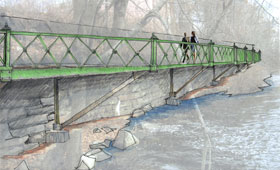Landscape Architecture Students Design
Project to Revitalize Willimantic River Area
 |
| A proposed cantilevered walkway along the Riverfront Trail in Willimantic. |
|
Illustration by Scott Heffernan |
On a spring day, paddles slap the water as kayakers maneuver their way down the Willimantic River. Families, couples, and individuals picnic in the parks, or hike on restored nature trails.
That’s the future envisioned by a group of students in UConn’s landscape architecture program in a service learning project they undertook last semester. Known as the Willimantic Whitewater Project, the plan seeks to revitalize the community by restoring the city’s river.
“The heart of this project lies in using the river to rebuild the fabric of the city,” says Paula Stahl, a research assistant in the plant science department who lives in Willimantic and volunteers as designer of the city’s “village community.” “Our goal was to reconnect the community to the river physically, visually, and economically.”
The project took about a month to complete, and culminated in a PowerPoint presentation given by the students at a city council meeting. The presentation was filmed and was aired on Charter Communications’ access channel last week.
UConn’s program in landscape architecture, the engineering side of designing outdoor spaces, is a four-year program, with four faculty members and 20 undergraduates per class. It focuses on projects that simulate professional landscape architecture work. Seniors in the program have been working on projects in Willimantic for the past five years.
“The UConn program is a resource for the town in planning its future,” says Stahl.
For the Whitewater Project, the students met with townspeople to clarify their environmental and tourism goals and come up with a mission statement. The students were charged with developing recommendations for a whitewater kayaking park, creating a park system linking the city to the river, and establishing a trail through the city, a continuation of the multi-use East Coast Greenway Trail that runs from Key West, Fla., to Calais, Me.
Students worked on opening access points to the river and creating new trails. The designs they produced included a riverside park that would connect Willimantic to the river through trails, play areas, and picnic spots. Walkways would connect the Main Street Historic District to the Prospect Hill Historic District and to Willimantic’s many museums, including the Train Museum, Windham Textile Museum, and other points of interest. Although the project is designed to boost the city’s economy, the parks and trails would serve as educational tools too, says Stahl.
When working on a project such as this, the students face considerable time constraints, says John Alexopoulos, an associate professor of landscape architecture. They may not have time for complete mapping, satellite imaging, groundwater studies, and historical and sociological impact studies, he says. They are not limited by cost considerations, however.
The students present a range of ideas, Alexopoulos says. It’s good training for them, and opens up a spectrum of possibilities to the local community.
“Through service learning projects like this, students get to see real world problems and work with real world people, he says. “They really get a feeling for the essence of a project.”
“The landscape architecture program is demanding,” says Eric Buck, a senior in the program. “Students can be found in our studio at all hours of the night.”
The presentation of options is as far as the landscape architect goes. After that, the city has to decide which suggestions, if any, to follow up, and must hire historians, architects, environmentalists, and others as needed.
Stahl says reaction to the students’ proposals has been very positive. The city is now looking for grants to help fund the project.

